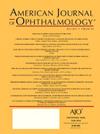Malignant Transformation of Ocular Melanocytoma to Uveal Melanoma: A Clinicopathologic Review of Three Novel Unsuspected Cases of a Likely Under-Recognized Phenomenon, With Review of the Literature and Molecular Genetic Data
IF 4.1
1区 医学
Q1 OPHTHALMOLOGY
引用次数: 0
Abstract
PURPOSE
To describe three cases of, and review the current knowledge regarding, malignant transformation of ocular melanocytoma (OM) to uveal melanoma (UM).
DESIGN
Retrospective clinicopathological case series and review of the literature.
METHODS
Clinical records and histopathology from three patients diagnosed with UM arising from a previously unsuspected OM were critically reviewed at a single academic institution. The patients’ demographic information, medical history, presenting clinical signs and symptoms, laboratory results, ancillary (including molecular genetic) testing, and management were collected. A literature review was conducted.
RESULTS
Three novel cases were identified, totaling 18 reported cases of malignant transformation of an OM to UM. The three new cases were diagnosed histopathologically on enucleation specimens for UM, without prior clinical history of OM. Where demographic information was available, ten patients were female and six male, with an average age at presentation of 45.75 years (range 15-69 years). For patients with an initial clinical diagnosis of OM, the interval to diagnosis of melanoma was between 0.25 years and 33 years, with the most common symptoms of evolution to UM being progressive vision loss, ocular pain, and elevated intraocular pressure. Six total cases did not have a previously known history of melanocytoma.
CONCLUSION
OM is rare; malignant transformation of OM to UM is also very uncommon. The incidental histopathological observation of darkly pigmented, polyhedral, magnocellular cells adjacent to or admixed with frank melanoma resulted in immunohistochemical confirmation of a precursor OM in three unsuspected cases, mimicking somewhat the appearance of UM with abundant admixed melanophages. OM may be a precursor to UM in more instances than previously recognized, and further data, as well as careful attention by pathologists, is needed to refine diagnosis and clinical management strategies regarding patients with known OM, especially outside of the optic nerve head.
眼黑色素细胞瘤向葡萄膜黑色素瘤的恶性转化:对三例可能未被认识的新病例的临床病理回顾,并对文献和分子遗传学数据进行回顾。
目的:报道3例眼黑色素细胞瘤(OM)向葡萄膜黑色素瘤(UM)恶性转化的病例,并对目前的研究进展进行综述。设计:回顾性临床病理病例系列和文献回顾。方法:在一个学术机构对3例诊断为UM的患者的临床记录和组织病理学进行了严格的审查,这些患者是由以前未被怀疑的OM引起的。收集患者的人口学信息、病史、临床体征和症状、实验室结果、辅助(包括分子遗传学)检测和管理情况。进行文献综述。结果:发现3例新病例,共18例报告的OM向UM恶性转化。这三个新病例是在没有OM临床病史的情况下,通过去核标本进行组织病理学诊断的。在人口统计资料中,女性10例,男性6例,平均发病年龄45.75岁(15-69岁)。对于最初临床诊断为OM的患者,诊断为黑色素瘤的时间间隔在0.25年至33年之间,发展为UM的最常见症状是进行性视力丧失、眼痛和眼压升高。6例既往无黑素细胞瘤病史。结论:OM罕见;OM向UM的恶性转化也很少见。偶然的组织病理学观察发现,与直率黑色素瘤相邻或混合的深色、多面体、大细胞细胞导致3例新病例的免疫组织化学证实为前体OM,在某种程度上模仿了UM的外观,有丰富的混合黑色素噬细胞。在更多的病例中,OM可能是UM的先兆,这比之前怀疑的要多。对于已知OM的患者,特别是视神经头外的OM,需要进一步的数据和病理学家的关注来完善诊断和临床管理策略。
本文章由计算机程序翻译,如有差异,请以英文原文为准。
求助全文
约1分钟内获得全文
求助全文
来源期刊
CiteScore
9.20
自引率
7.10%
发文量
406
审稿时长
36 days
期刊介绍:
The American Journal of Ophthalmology is a peer-reviewed, scientific publication that welcomes the submission of original, previously unpublished manuscripts directed to ophthalmologists and visual science specialists describing clinical investigations, clinical observations, and clinically relevant laboratory investigations. Published monthly since 1884, the full text of the American Journal of Ophthalmology and supplementary material are also presented online at www.AJO.com and on ScienceDirect.
The American Journal of Ophthalmology publishes Full-Length Articles, Perspectives, Editorials, Correspondences, Books Reports and Announcements. Brief Reports and Case Reports are no longer published. We recommend submitting Brief Reports and Case Reports to our companion publication, the American Journal of Ophthalmology Case Reports.
Manuscripts are accepted with the understanding that they have not been and will not be published elsewhere substantially in any format, and that there are no ethical problems with the content or data collection. Authors may be requested to produce the data upon which the manuscript is based and to answer expeditiously any questions about the manuscript or its authors.

 求助内容:
求助内容: 应助结果提醒方式:
应助结果提醒方式:


